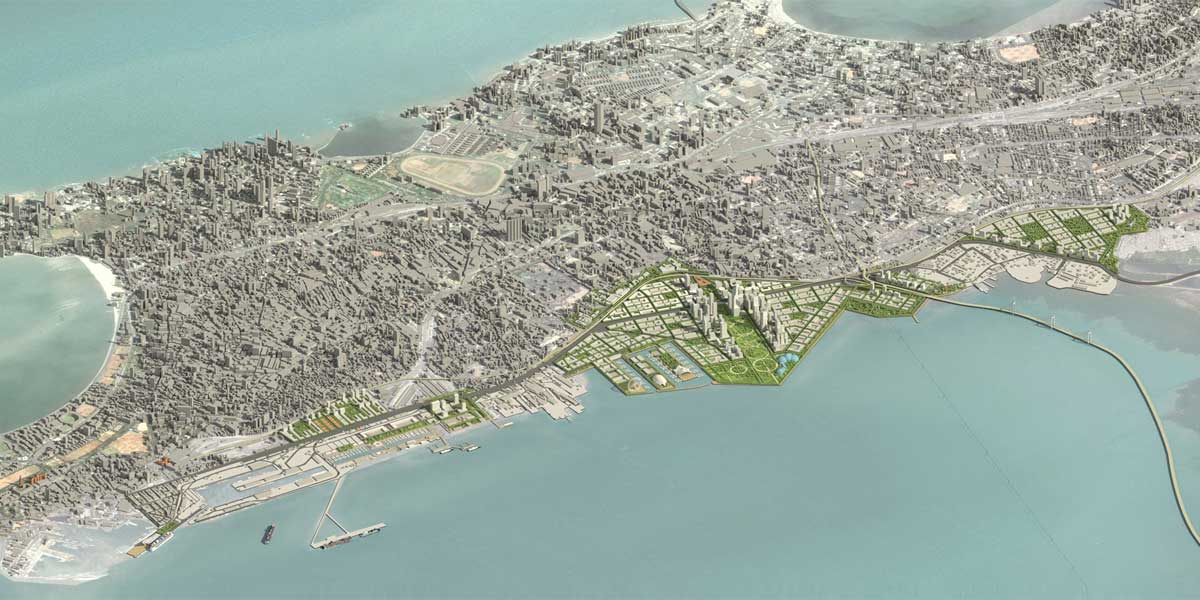By 2030, Mumbai is expected to become a megalopolis with a population in excess of 30 million and potential economic GDP in excess of $ 250 billion. But this will only be possible if the city is able to attract talent, investment and entrepreneurs. Redeveloping Mumbai’s port land is one of the ways to make Mumbai liveable and enable it to emerge as the hub for innovation and entrepreneurship in India.
APLI Mumbai, a port land initiative, was formed by the late Meera Sanyal and Vice Admiral (Retd) IC Rao, PVSM, AVSM, along with several design groups and thinktanks as a response to the Rani Jadhav Committee Report (on port waterfront and land development in Mumbai), to develop a ‘people’s vision’ for the city and its port lands, shares Sarfaraz Momin, Founding Partner, StudioPOD, Mumbai.
Redeveloping port lands for a liveable Mumbai
Momin shares Apli Mumbai’s mantra for wellness and recreation in the port lands:
Understanding what people need in terms of infrastructure
Connecting back to nature
Bringing places closer by increasing affordable connectivity and improving accessibility through non-polluting modes of public transportation
Developing smart infrastructure to help recharge groundwater, leverage open space to accommodate underground utilities, and much more
Connecting people to water through increased water-related employment, engendering a sense of identity of a coastal city, creating nodes for water recreation and developing a publicly accessible waterfront.
Infrastructure is taking an interesting turn around the world and people are thinking about parks, gardens and landscapes and sustainable development in a very different and systematic way. “Gardens and parks need to be designed such that our cities still survive in case of a sea-level rise,” he says. “Based on this, we group came together to deliberate upon a protective layer all around Mumbai, which would be a 60-km continuous pedestrian and cycling trail. Here, the eastern port land will play a very important role. A publicly accessible waterfront all around the city will also create a buffer or green refuge.”
Key piece of the puzzle: A publicly accessible waterfront
The land area of Mumbai Port has been acquired mainly by reclamation in the 19th and early 20th centuries. From the 1920s, the land was leased for 60 years for industrial and commercial use. These leases have expired and the port trust and government have decided not to renew them. Now, there is 400 acre to be redeveloped or regenerated. “However, this land is currently under litigation with 1,500 lessees,” says Rao.
The reason for this land becoming available is that the Jawaharlal Nehru Port (JNPT) in Navi Mumbai has developed into a major container and bulk cargo port, leading to a decline in traffic in Mumbai Port. Further, the environmental clearance for JNPT included a provision that with the reduction of cargo traffic in Mumbai Port, dock areas not required for cargo operation should be made available for greening and recreation. “The land we are talking about spans 709 hectare; 201 hectare is planned for gardens, roads, open spaces and tourism-related facilities, 66 hectare is planned as a built-up area for commercial exploitation and 93 hectare is proposed additionally for reclamation for the central park,” informs Rao.
“Our idea for the eastern port land is a place where the entire city has access to social hubs,” shares Momin. “On the eastern waterfront, we can embrace water transport owing to the conducive conditions. We propose constructing passenger water transport (PWT) terminals along the entire eastern waterfront. Of these PWT stops, a few should act as major trans-harbour or coastal ferry terminals, providing connectivity to Navi Mumbai, JNPT, Uran, Alibagh, Goa, etc. We are really close to achieving this ’15-minute city’ everyone is talking about. We are suggesting integrated connectivity of all modes of public and non-motorised transport. We are also proposing a light-rail transit/streetcars for last kilometre connectivity.”
Further, Momin says, “We have taken the central neighbourhood of Haji Bunder and created a vision plan to develop a green edge all along the city and then looking at how the stormwater flows, how we can actually capture all of this and then create the park system and develop the entire concrete infrastructure.”
The Mumbai Eastern Waterfront project
A key element of the port land development vision is the Mumbai Eastern Waterfront project.
Planner, Construction World Maharashtra, tells us, “The Mumbai Eastern Waterfront is a mass upliftment project that is likely to set a new global benchmark and help improve the living standards of many people.” The project has six objectives:
1. Doubling Mumbai’s GDP while creating 900,000 new jobs
2. Increasing Mumbai’s green cover by 600 per cent in Phase 1
3. Permanently sequestering toxic waste in Mumbai’s creeks on a waste island
4. Improving water quality to levels that restore fish populations
5. Creating affordable housing for 1.2 million people
6. Improving connectivity and reducing traffic in South Mumbai.
Developments along the waterfront
Puntambekar shares an overview of the main developments along the new waterfront:
Supertall buildings complex: Four iconic buildings spread over 60 acre at a cost of $ 4.18 billion (Rs 31,350 crore)
New business district: 60 acre in a plot adjoining the supertall buildings complex at about $ 4.5 billion (Rs 33,750 crore) with office spaces, luxury hotels and convention centres
Government compound: For relocation of the Maharashtra government from the current Mantralaya location at an estimated Rs 9,000 crore with a 15-acre legislature complex, a large amphitheatre for public meetings, government offices complex and ministers’ residences
Disneyland and entertainment precinct: The largest part of the project covering 150 acre at an estimated investment of $ 16 billion (Rs 120,000 crore) to be built in phases, with a 90-acre Disneyland, two unique theme parks of 15 acre each, two large theatres and convention centres, a 10-acre ocean world and a 20-acre bird park
Portlands University: Spread over 250 acre at a planned investment of $ 39.08 billion (Rs 2.93 lakh crore) with over 90 different schools/disciplines, ultra-modern laboratories, world-class housing for 1,000 faculty and staff and classrooms to accommodate 20,000 students.
Affordable/mass housing: About 600 acre of area currently occupied by the RCF, BPCL, HPCL and Tata power plants to be reassigned.
Financing the Eastern Waterfront project
As for financing, Puntambekar references the urban equity model and cites the case of L&T’s presentation to the Maharashtra government in 2015 regarding a 93-acre plot in Bandra East—the company’s idea was to spend Rs 30,000 crore on the property and sell it for Rs 125,000 crore. This is the idea that will be used for the Eastern Waterfront project and will help generate a lot of money.
Total capital that will be raised by the Eastern Waterfront Redevelopment Corporation (to be set up by the Government of India) is Rs 419,400 crore by monetising government and offshore land. SPVs 1 to 5 will be PPP companies with a 26 per cent government stake. SPV 6 will receive a direct grant of Rs 180,000 crore and some of its projects will be structured as PPPs.
Project imperatives
So, what’s needed to execute projects of this scale?
According to Chintan Patel, Partner, Real-Estate Advisory, KPMG India, the country has the ability to execute the project with no dearth of capital and many sources, such as banks, development agencies, multilateral to large sovereign funds and creative financial instruments like zero coupon bonds. He adds the project will have a massive impact on Mumbai. “Breaking it into bite-size projects and having multiple people take up these projects as opposed to one large developer will make it see the light of day.”
According to Dr Niranjan Hiranandani, MD, Hiranandani Group, the project is an opportunity that should be executed by modifying and improving upon the many good ideas available. “However,” he adds, “we should aim to make something more. For example in the master plan of Mumbai, which is already part of the development plan, the 300-acre garden right from NCPA up to Cuffe Parade is an opportunity to work on.” In his view, while we do not have the price execution capacity required currently, proper leadership and proper economic spotting will help get things together.
- By Praharshi Saxena




















